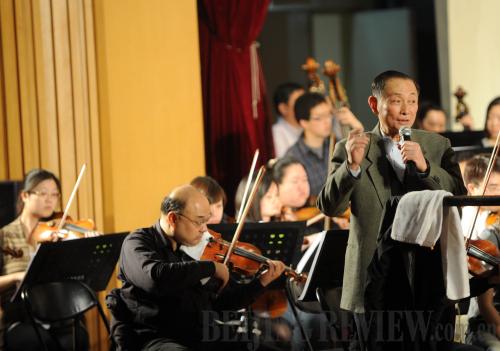|
 |
|
SYMPHONIC OPERA: Mei Baojiu rehearses on April 12 for the performance merging Peking Opera and symphony the next day (XINHUA) |
Mei Baojiu, a well-known Peking Opera performing artist, and Hu Yongyan, a famous orchestra conductor, took the stage together, one wearing a Peking Opera costume, and the other wearing a Western suit. Their combined performance filled the Beijing Concert Hall nearly to capacity on April 13, 2011, as part of the program of spreading symphony to more people.
Besides the diversely costumed performers, violins, cellos, and trombones, were mixed with erhu, a two-stringed traditional Chinese instrument played with a bow, and yueqin, or zither. Such a sonic combination is rarely heard.
"It would seem as though Peking Opera and symphony orchestra can't match each other at all," said Mei. "It is not true." Mei revealed that he developed his vocal skills by listening to symphonic music when he was young and this helped a lot in his opera performance.
Hu compares Western symphony orchestra and Peking Opera as distant cousins. "They both have histories of several hundred years and the prime time of the Peking Opera coincides with the prime time of symphony," said Hu, who added more similarities of these two art forms. Peking Opera was always performed in royal and rich families, so was symphony orchestra in old times.
"Now both of them face the same problems, such as declining audiences and promotional difficulties," said Hu. "The combination of these two forms might help both to be more popular in different countries."
Ye Xiaogang, Vice President of the Central Conservatory of Music in Beijing, was in the audience at this performance, and regarded it as a good way to encourage musical communication between the East and West. "To promote Peking Opera in foreign countries and symphony in China, it is better to include local elements that can be more easily accepted by local people," said Ye. "This is a good effort."
But some audiences have different opinions, saying Peking Opera and symphony are of totally different styles and the combined sound is weird.
Lu Jiawen, a symphony aficionado in attendance, is one of those opponents. "There is a trend in China that almost all the performance forms can be mixed with symphony," said Lu. "It is ridiculous." He added, "For me, combining Peking Opera with symphony is just like eating Chinese dishes with coffee. They just don't match."
Hu admitted there are problems with the combination, and Chinese artists are still on the way to improve it. "The combination of Peking Opera and symphony is not new in China. In 1967, Taking Tiger Mountain by Strategy was performed by Shanghai Peking Opera Troupe with accompaniment by the Shanghai Symphony Orchestra," Hu said.
"The combination is not just simply putting Peking Opera and a symphony on stage together," said Ye. "It needs skills to adapt them to each other."
| 